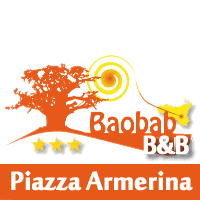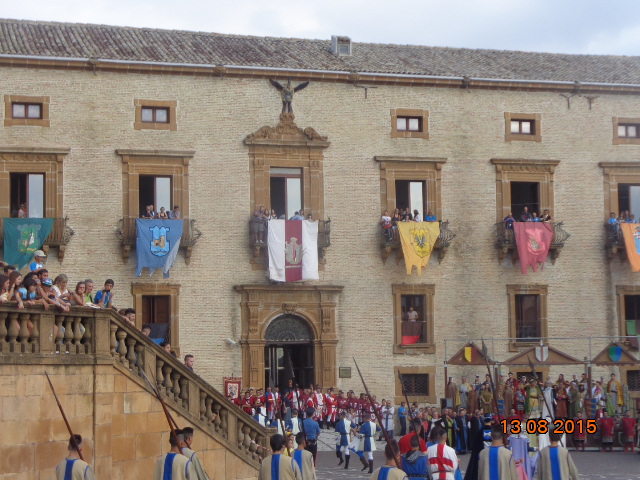Home - In and around
PALACE TRIGONA PIAZZA ARMERINA
Palace Trigona Piazza Armerina
And 'it belonged to the noble family the most important and long-lived in Piazza Armerina; Their possessions were scattered throughout Sicily.
From 1500 until the first half of 1800 the dynasty of Trigona, in fact, it has grown more conquering new territories and reaching an important role within the aristocracy of the island. The majesty of the palace it is the concrete evidence, it was built on the east side of the square where stands the Cathedral, also wanted and financed by Trigona, at the summit that dominates the whole of Piazza inhabited.
Work began at the end of the seventeenth century. and completed in the first half of the eighteenth; Matthew Trigona, future bishop of Syracuse, and his brother Ottavio began to actively take care of this work around 1690, when it undertook the purchasing operations of the surrounding houses to those already owned by them; although the works on the decorations continued on several occasions, according to the renewed taste of those who once lived there, until about 1920.
There is no evidence that they can attribute with certainty a signature design but, it can be said that in all probability was the architect Orazio Torriani, who followed the work of the Cathedral, to contribute to the choices and ideas for the construction of the Palace.
The architect Franco Minissi that, in a first phase, oversaw the restoration, maintains that "... it is the work of local workers still tied to decorative patterns of the past...".
The plan is rectangular, with an internal courtyard, spread over three floors and the spacious and comfortable attic. Built in stone, and local sandstone terracotta brick, presents the north elevation, one on the Cathedral Square, bounded by pilasters and in the center a large portal, balconies with railings of great value, and windows. The architectural composition resumes compositional language of the time, with a stand, which is inserted Mezzano Plan, the hanging that makes up the main floor and the crowning with Cadet Plan.
At the center, on the lintel of the central balcony, it stands the frieze of the house symbol: the golden eagle characterized by a shield with blue sky background, a triangle, on the bottom left corner, and a comet, at the top right. The entrance hall leads into the inner courtyard, the local Terrans and a wide staircase leading to the main floor, the ground floor was used as warehouses and stables. The first floor was originally paved with precious ceramics of Caltagirone, lost, today expertly reproduced based on original fragments, while the ceilings are covered in time is a fight that cruise, all painted with floral motifs and neo-classical landscapes, now completely restored. In particular, the right wing of the main floor consists of two large rooms with ceilings decorated in gold and pastel representatives fauna and flora. The first of these rooms contains the family chapel, locked inside a large closet with a wooden altar and a reliquary.
The Palace has passed in the availability of the Region since 1960, with no moving precious eighteenth century and the works of art held by the last heirs.
Now the Archaeological Park Service of the Villa Romana del Casale and the archaeological sites of Piazza Armerina and neighboring municipalities, is the Porta del Parco, inside it will find accommodation for the Park Office to become the Management Centre of the whole activity.
the main target will be the Museum of the Territory and the City with an exhibition of some permanent collections, from the excavations of archaeological sites in the area, as well as objects, documents and materials that illustrate the history of the City of Piazza Armerina.
The Palace will also host exhibitions and temporary exhibitions, home to conferences, debates, meetings and on the mosaics and Study Centre on the archeology of late antiquity, connected to the most important institutions of the sector, with reference to the whole Mediterranean area, representing the Villa del Casale a prime example of cultural mediation, for the meeting of the north African cultures and Western Roman Empire.
Palazzo Trigona is also home to the BIAM (the Biennial of the Mediterranean Art), in the design phase, it will look for artists from the Mediterranean, on the theme of confrontation and knowledge of the different cultural components.
source: the Roman villa of the farmhouse
And 'it belonged to the noble family the most important and long-lived in Piazza Armerina; Their possessions were scattered throughout Sicily.
From 1500 until the first half of 1800 the dynasty of Trigona, in fact, it has grown more conquering new territories and reaching an important role within the aristocracy of the island. The majesty of the palace it is the concrete evidence, it was built on the east side of the square where stands the Cathedral, also wanted and financed by Trigona, at the summit that dominates the whole of Piazza inhabited.
Work began at the end of the seventeenth century. and completed in the first half of the eighteenth; Matthew Trigona, future bishop of Syracuse, and his brother Ottavio began to actively take care of this work around 1690, when it undertook the purchasing operations of the surrounding houses to those already owned by them; although the works on the decorations continued on several occasions, according to the renewed taste of those who once lived there, until about 1920.
There is no evidence that they can attribute with certainty a signature design but, it can be said that in all probability was the architect Orazio Torriani, who followed the work of the Cathedral, to contribute to the choices and ideas for the construction of the Palace.
The architect Franco Minissi that, in a first phase, oversaw the restoration, maintains that "... it is the work of local workers still tied to decorative patterns of the past...".
The plan is rectangular, with an internal courtyard, spread over three floors and the spacious and comfortable attic. Built in stone, and local sandstone terracotta brick, presents the north elevation, one on the Cathedral Square, bounded by pilasters and in the center a large portal, balconies with railings of great value, and windows. The architectural composition resumes compositional language of the time, with a stand, which is inserted Mezzano Plan, the hanging that makes up the main floor and the crowning with Cadet Plan.
At the center, on the lintel of the central balcony, it stands the frieze of the house symbol: the golden eagle characterized by a shield with blue sky background, a triangle, on the bottom left corner, and a comet, at the top right. The entrance hall leads into the inner courtyard, the local Terrans and a wide staircase leading to the main floor, the ground floor was used as warehouses and stables. The first floor was originally paved with precious ceramics of Caltagirone, lost, today expertly reproduced based on original fragments, while the ceilings are covered in time is a fight that cruise, all painted with floral motifs and neo-classical landscapes, now completely restored. In particular, the right wing of the main floor consists of two large rooms with ceilings decorated in gold and pastel representatives fauna and flora. The first of these rooms contains the family chapel, locked inside a large closet with a wooden altar and a reliquary.
The Palace has passed in the availability of the Region since 1960, with no moving precious eighteenth century and the works of art held by the last heirs.
Now the Archaeological Park Service of the Villa Romana del Casale and the archaeological sites of Piazza Armerina and neighboring municipalities, is the Porta del Parco, inside it will find accommodation for the Park Office to become the Management Centre of the whole activity.
the main target will be the Museum of the Territory and the City with an exhibition of some permanent collections, from the excavations of archaeological sites in the area, as well as objects, documents and materials that illustrate the history of the City of Piazza Armerina.
The Palace will also host exhibitions and temporary exhibitions, home to conferences, debates, meetings and on the mosaics and Study Centre on the archeology of late antiquity, connected to the most important institutions of the sector, with reference to the whole Mediterranean area, representing the Villa del Casale a prime example of cultural mediation, for the meeting of the north African cultures and Western Roman Empire.
Palazzo Trigona is also home to the BIAM (the Biennial of the Mediterranean Art), in the design phase, it will look for artists from the Mediterranean, on the theme of confrontation and knowledge of the different cultural components.
source: the Roman villa of the farmhouse



